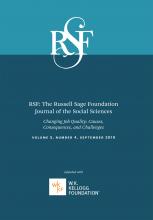Research Article
Open Access
The Geography of Polarization, 1950 to 2015
Tom VanHeuvelen, Katherine Copas
RSF: The Russell Sage Foundation Journal of the Social Sciences September 2019, 5 (4) 77-103; DOI: https://doi.org/10.7758/RSF.2019.5.4.03
Tom VanHeuvelen
aAssistant professor of sociology at the University of Minnesota
Katherine Copas
bPhD candidate of sociology at the University of Illinois at Urbana-Champaign

REFERENCES
- ↵
- Abowd, John M.,
- Kevin L. McKinney, and
- Nellie L. Zhao
- ↵
- ↵
- ↵
- ↵
- ↵
- Bloome, Deirdre
- ↵
- Brady, David,
- Regina S. Baker, and
- Ryan Finnigan
- ↵
- ↵
- Charles, Kerwin Kofi,
- Erik Hurst, and
- Mariel Schwartz
- ↵
- ↵
- ↵
- Diamond, Rebecca
- ↵
- Dorn, David
- ↵
- ↵
- ↵
- ↵
- Economic Policy Institute
- ↵
- Florida, Richard
- ↵
- Frey, William
- ↵
- Ganong, Peter, and
- Daniel Shoag
- ↵
- Glaeser, Edward L
- ↵
- Glaeser, Edward L., and
- Joshua D. Gottlieb
- ↵
- Glaeser, Edward L.,
- Matt Resseger, and
- Kristina Tobio
- ↵
- Goos, Maarten, and
- Alan Manning
- ↵
- Holliday, Amy L., and
- Rachel E. Dwyer
- ↵
- Holzer, Harry,
- Julia Lane,
- David Rosenblum, and
- Fredrik Andersson
- ↵
- Hsieh, Chang-Tai, and
- Enrico Moretti
- ↵
- ↵
- Kalleberg, Arne L
- ↵
- ↵
- Lee, Barrett A., and
- Matthew Marlay
- ↵
- ↵
- ↵
- Lichter, Daniel T., and
- Kai A. Schafft
- ↵
- Lindert, Peter H. and
- Jeffrey G. Williamson
- ↵
- Lindsey, Brink, and
- Steven Teles
- ↵
- ↵
- ↵
- Manning, Alan
- ↵
- Massey, Douglas S
- ↵
- Massey, Douglas S.
- ↵
- Massey, Douglas S., and
- Mary J. Fischer
- ↵
- ↵
- McCall, Leslie
- ↵
- ↵
- ↵
- Molloy, Raven,
- Christopher L. Smith, and
- Abigail Wozniak
- ↵
- Moretti, Enrico
- ↵
- Moretti, Enrico
- ↵
- Mouw, Ted, and
- Arne Kalleberg
- ↵
- ↵
- Pager, Devah
- ↵
- Pattillo, Mary, and
- John N. Robinson III.
- ↵
- ↵
- Piketty, Thomas,
- Emmanuel Saez, and
- Gabriel Zucman
- ↵
- ↵
- ↵
- ↵
- Song, Jae,
- David J. Price,
- Fatih Guvenen,
- Nicholas Bloom, and
- Till Von Wachter
- ↵
- ↵
- ↵
- Strain, Michael R
- ↵
- Tolbert, Charles M., and
- Molly Sizer
- ↵
- VanHeuvelen, Tom
- ↵
- VanHeuvelen, Tom
- ↵
- Weeden, Kim A., and
- David B. Grusky
- ↵
- Weil, David
- ↵
- Western, Bruce, and
- Jake Rosenfeld
- ↵
- Wilmers, Nathan
- ↵
- Wilson, William Julius
- ↵
- Wozniak, Abigail
- ↵
- ↵
In this issue
The Geography of Polarization, 1950 to 2015
Tom VanHeuvelen, Katherine Copas
RSF: The Russell Sage Foundation Journal of the Social Sciences Sep 2019, 5 (4) 77-103; DOI: 10.7758/RSF.2019.5.4.03





